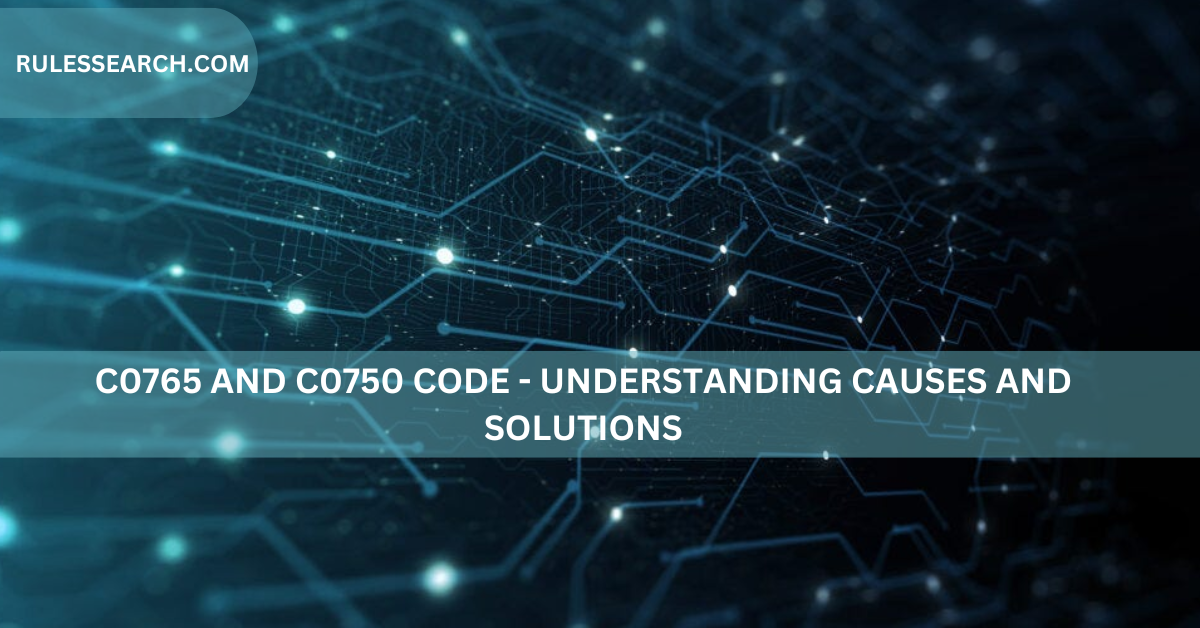Encountering diagnostic trouble codes (DTCs) like C0765 0x4750 and C0750 0x4765 on your device can be daunting. These codes are designed to alert you to specific issues within your vehicle or machinery. Understanding what they mean and how to address them is crucial for maintaining optimal performance. This guide will delve into the meanings of these codes, explore common causes, and provide detailed troubleshooting steps to help you resolve these issues effectively.
What Are the C0765 and C0750 Codes?
Diagnostic Trouble Codes (DTCs) are alphanumeric codes used by diagnostic tools to identify issues within a system. The codes c0765 and c0750 code are examples of such codes, indicating specific faults that need attention.
- C0765 0x4750: This code is typically associated with a malfunction in a particular component or system. The exact meaning can vary depending on the make and model of your device, but it generally points to a problem that needs addressing.
- C0750 0x4765: Similar to C0765, this code indicates a fault in a different component or system. Understanding the specific nature of this fault is crucial for effective troubleshooting and repair.
Common Causes of C0765 and C0750 Codes
Several factors can trigger these codes. Identifying the root cause is essential for proper resolution. Here’s a detailed look at the common causes:
1. Hardware Issues
- Faulty Sensors: Sensors play a critical role in monitoring various aspects of your device’s performance. If a sensor is malfunctioning, it can provide incorrect readings or fail to operate, leading to diagnostic codes. Symptoms of faulty sensors include erratic behavior of the device or warning lights on the dashboard.
- Wiring Problems: Damaged or loose wiring can disrupt the flow of signals between components and the central control unit. This can lead to communication errors and the generation of diagnostic codes. Common signs of wiring issues include visible damage, frayed wires, or loose connections.
2. Software Glitches
- Firmware Errors: The firmware controls how your device operates and processes information. Outdated or corrupted firmware can cause the system to misinterpret data, resulting in diagnostic codes. Firmware errors can be resolved by updating to the latest version provided by the manufacturer.
- System Updates: If your device’s software is outdated, it may not function properly, leading to the generation of diagnostic codes. Regularly updating your system’s software can help prevent such issues.
3. Mechanical Failures
- Component Wear and Tear: Over time, mechanical components can wear out due to regular use. This wear and tear can lead to malfunctions that trigger diagnostic codes. Common examples include worn-out belts, gears, or bearings.
- Improper Calibration: Components that are not calibrated correctly can cause the system to detect faults. Recalibration may be needed to ensure that all components function correctly and within specified parameters.
How to Troubleshoot C0765 and C0750 Codes
To effectively address these codes, follow these detailed troubleshooting steps:
1. Check for Hardware Issues
- Inspect Sensors: Start by examining all relevant sensors for damage or debris. Clean or replace any sensors that appear faulty. Use diagnostic tools to test sensor performance and verify that they are functioning within the manufacturer’s specifications.
- Examine Wiring: Check all wiring connected to the affected components. Look for signs of damage, such as cuts, frays, or exposed wires. Repair or replace any damaged wiring and ensure all connections are secure.
2. Update and Reset Software
- Update Firmware: Visit the manufacturer’s website to check for firmware updates. Download and install any available updates to ensure that your device’s software is current. This can resolve issues related to outdated or corrupted firmware.
- Reset the System: Sometimes, resetting the system can clear temporary glitches that might be causing the codes. Follow the manufacturer’s instructions for performing a system reset, which typically involves powering off the device, waiting a few minutes, and then turning it back on.
3. Address Mechanical Problems
- Inspect Components: Perform a thorough inspection of mechanical components for signs of wear or damage. Replace any components that appear to be malfunctioning or worn out.
- Recalibrate Components: If components are not properly calibrated, follow the manufacturer’s guidelines for recalibration. This process may involve using specialized tools or software to adjust the settings of the affected components.
When to Seek Professional Help
If you’ve gone through the troubleshooting steps and are still encountering issues, or if the problem seems too complex, it may be time to consult a professional technician. A qualified technician can perform a more detailed diagnosis and address any underlying problems that might not be immediately visible.
Conclusion
Understanding and resolving c0765 and c0750 code can be challenging, but with a systematic approach, you can effectively address these issues. By identifying common causes and following the troubleshooting steps outlined in this guide, you can restore your device to optimal performance and ensure it operates smoothly.
Frequently Asked Questions (FAQs)
What do the C0765 and C0750 codes indicate?
The C0765 and C0750 codes are diagnostic trouble codes that signal specific issues within your device’s systems. They point to faults that need to be addressed to ensure proper operation.
How can I identify if a sensor is faulty when dealing with the C0765 or C0750 code?
To identify a faulty sensor related to the C0765 or C0750 code, check the sensor for visible damage or debris. Use diagnostic tools to test the sensor’s performance and compare it with the manufacturer’s specifications.
What should I do if I find damaged wiring associated with the C0765 or C0750 code?
If you find damaged wiring related to the C0765 or C0750 code, repair or replace any damaged wiring. Ensure all connections are secure to restore proper communication between components.
Can software updates fix issues related to the C0765 and C0750 codes?
Yes, updating the firmware can resolve software-related issues that may be causing the C0765 and C0750 codes. Check for and install any available updates from the manufacturer.
How often should I recalibrate components to address the C0765 and C0750 codes?
Calibration schedules for addressing the C0765 and C0750 codes vary based on the manufacturer and component. Refer to your device’s manual for specific calibration recommendations.
What are the signs of component wear and tear that might trigger the C0765 or C0750 codes?
Signs of component wear and tear that might trigger the C0765 or C0750 codes include unusual noises, reduced performance, or visible damage to components.
How can I reset the system to clear the C0765 and C0750 codes?
To clear the C0765 and C0750 codes, follow the manufacturer’s instructions for resetting the system, which usually involves powering off the device, waiting a few minutes, and then restarting it.
When should I consult a professional technician regarding the C0765 and C0750 codes?
If troubleshooting does not resolve the C0765 and C0750 codes or if the problem seems complex, seeking professional help is advisable. A technician can perform a detailed diagnosis and repairs.
Are there any preventive measures to avoid encountering the C0765 and C0750 codes in the future?
To avoid encountering the C0765 and C0750 codes in the future, engage in regular maintenance, timely updates, and periodic inspections. Follow the manufacturer’s recommendations for upkeep.
How can I find more information about the C0765 and C0750 codes?
For more information about the C0765 and C0750 codes, refer to your device’s service manual or consult the manufacturer’s website for detailed information about diagnostic codes and troubleshooting procedures.



